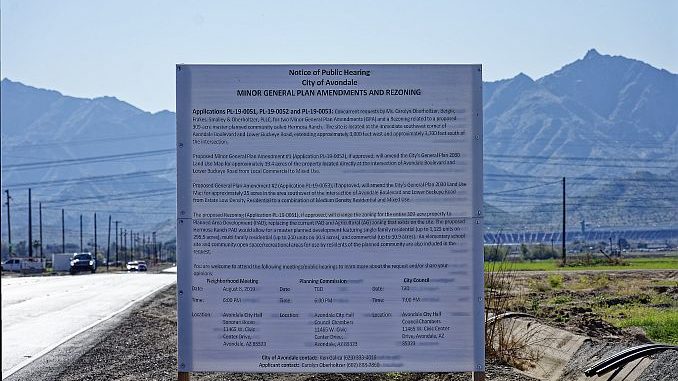
At WeSERV Government Affairs we regularly offer suggestions to cities and towns when zoning codes are reviewed or proposed. Because WeSERV members sell properties that are 100 years old or older, we offer our experience to local governments in what people dislike and like over time. Some zoning principles provide for neighborhoods that are desired over generations. Those same principles help ensure the future economy through well planned commercial and agricultural areas.
Increasingly over the past two years we have seen attempts at the Arizona State Legislature to encroach on local government city plans and zoning. At the same time state law requires cities, towns and counties who have adopted zoning to update their General Plans every ten years.
During that review local government is required to provide opportunities for public input so the community can discuss and suggest city plan elements that provide residents and businesses the future they want and need. The review also provides an opportunity for communities to reassess previous wants and needs in view of changing economies.
Things change over a decade, not least of which are demographics and economics. Finding a balance between public needs and private property rights is important and the Land Use Map contained in the General Plan is one way of noticing residents and businesses where to place various land use projects.
With the increase in attempts to limit or even override portions of local community zoning codes, it might to be helpful to remember why zoning codes were created.
Local zoning ordinances are considered to have begun in 1904 Los Angeles. The purpose was to help create residential areas separate from industrial uses. Wash Houses, laundries, slaughterhouses, tanneries and other uses were prohibited in residential areas.
In 1916 New York adopted a city wide zoning ordinance in response to the Equitable Building towering over residents, blocking air, sun light, and because the building covered the entire lot, causing increased traffic congestion with only on street parking. The zoning code prevented warehouses and factories from being in residential areas as well.
In 1921 the Department of Commerce Secretary Herbert Hoover formed an advisory committee on zoning. At that time only 48 cities or towns had zoning ordinances. By the end of 1923 more than 218 municipalities had zoning ordinances. And by 1925 several more states had added zoning ordinance enabling language to state law- including Arizona. The enabling language did not mandate zoning ordinances, it allowed local communities to install zoning by a vote of the people.
The stated purpose of zoning ordinances was to promote health, safety, reduce street congestion, prevent overcrowding and provide adequate infrastructure (sewers, water, schools, parks, etc.). Secretary Hoover released an initial edition of A Standard State Zoning Enabling Act by the Advisory Committee on Zoning in 1924 with an update released in 1926.
With the ongoing attempts to chip away at local zoning, perhaps the better question to ask is Does local zoning still work for communities?
The process to establish land use and zoning can be very lengthy when first establishing a use or making a major change to the already established use. On the other hand, it can be very quick if all the elements align to an already established and approved use. Think back just a few years to 2018 and 2019. Development was moving fast. In part because some projects previously abandoned were being renewed and since little or nothing was being change to the previously approved plan, approvals happened quickly. The shortest time period we saw was 4 months from the time paper work was submitted to the turning of dirt.
Residents want to know what is being planned and if their residence will be affected by future plans. One of the first questions homebuyers and renters ask is “what’s going to go there?” when they see an empty lot or farm. They want to know the current plan. They understand plans change, but they want to know and have input on those changes.
Business owners and investors want to know the area they have chosen to locate is the best choice based on synergies in a business district, residential area, mixed use area, a manufacturing area, medical corridor, agricultural area, entertainment district, historical area or other land use type. They want to know Infrastructure needs have been planned for and considered. Investment is already risky. Knowing what to expect in the future helps take away some of the risk.
Rather than haphazardly chipping away at zoning from a state legislative level, perhaps we should ask these questions:
- Should Cities, Towns and Counties use the zoning tool?
- Do residents and businesses need and want to impart their vision and hopes for their community?
- Are there reasons zoning was adopted by so many local governments?
- Does zoning unreasonably encroach on private property rights?
The very problems critics assign to zoning are the problems zoning was adopted to fix. Each local community is best suited to decide if the 100 year promise of zoning has served it well. Diminishing local zoning and planning through limiting state legislation renders the zoning tool inadequate and unusable to the declared task.
Rather than damage the tool of zoning rendering it useless, initiate a thoughtful conversation at the local level of those affected by the decision – residents, businesses and voters. Allow the voters to express their decision on the future of zoning for their city or town through the ballot box.

